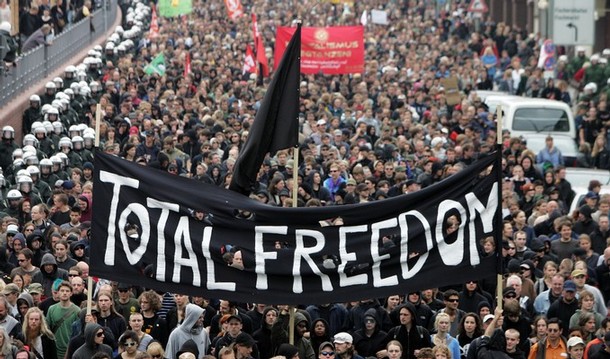May Day: History, Hype and Dignified Revolt
May 01, 2013


This text is reprinted from a May Day flyer. For more on the history of May Day, see the zine “Hurrah for Anarchy!” and for what happened last year, see the post “May Day 2012.”
On May 1, 1886 tens of thousands of workers across the country went on a three day general strike in support of the 8 hour work day. On May 3rd workers in Chicago attempted to confront strikebreakers that were entering a plant where workers had been locked out since February and supported the call for a eight hour work day. The strikebreakers had the protection of hundreds of police and when the striking workers surged forward to meet them at the gates of the factory the police opened fire killing 2-6 workers. The next day May 4th, in response, anarchists called for a rally at Haymarket Square in Chicago. When police ordered the rally to disperse and marched forward in formation a bomb was thrown toward the police: a riot ensued; untold numbers of workers were killed and injured by police bullets. The bomb as well as gunshots from mostly friendly fire killed eight cops. Eight anarchists were later imprisoned in retribution and known as the Haymarket martyrs. Each was tried for murder, the incident and trial led to indignation around the world as the prosecution conceded that none of the eight threw the bomb. The eight were not on trial for throwing bombs, but for being radical labor agitators and anarchists. Two had their sentences commuted to life in prison, one received fifteen years, four were eventually executed, and one cheated the hangman by taking his own life in prison. The anarchist idea did not die in Chicago in 1887. Today it still inspires the struggle against global capitalism and the state.
It is a tradition born in Chicago, mummified in Russia and China, celebrated as workers day in much of the world, and until more recently largely neglected in the U.S. It’s no surprise if in Seattle, Mayday means little more than last years mini-riot considering the recent media blitz. Contrary to the mainstream media lies about an anarchist hijacking of last years Mayday, thousands of people took to the streets to express their anger with the current system in numerous different ways. The protests downtown were organized with the ideas of decentralization and autonomy, in practice this meant that small groups were encouraged to act as they saw fit. There were multiple demonstrations and activities throughout the day, at different times, with different themes and focuses, and anarchists participated in many of these. An anti-capitalist march started at noon with the slogan “Destroy What Destroys You.” It was openly confrontational with capitalism and the state. Smoke bombs and paint were thrown, banks, large businesses, and the federal court house had their windows broken. The mainstream media was attacked, a few cars got trashed, and people defended themselves from vigilantes and the police. The mayor declared his ability to use his emergency powers and for the rest of the evening part of downtown Seattle was boarded up. The idea that private property is sacred was publicly challenged by hundreds of people and business as usual in downtown Seattle was disrupted for the day by thousands.
A Mayday where the legitimacy of so much is challenged, whether it be bosses, borders, corporate property, or marching behind the same reformist leaders, should always be welcome. However inevitably it is a day that makes those with money or power or simply those invested in the way things are, call for more repression and control. After all Mayday is part of a long struggle against capitalism, the state, and this society which runs on misery. The media sells the narrative of the police, the politicians, and the business owners, all in an effort to justify repression and conceal the fact that Mayday can be and has been a important part of social struggle. The dominant narrative today is a small extension of their past victories of genocide, imprisonment, and social control. However direct experience and the forgotten history of Mayday tell us another story, that of dignified revolt against a network of domination, exploitation, and control.
Share on Social Media
- Share on Mastodon
- Share on Twitter
- Share on Facebook
- Share on Tumblr
- Share on Reddit
- Share on Telegram
- Share on WhatsApp
These links are not an endorsement of social media. They are provided for convenience and to help foster the spread of anarchist ideas.